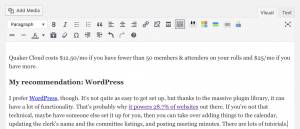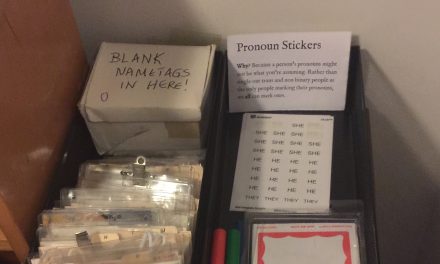Trying to decide on what tech to use can easily result in somebody in serious analysis paralysis. Want to skip the research and just be told a working set of tech to use for your meeting? I got your back.
TL;DR
This is a long post. Don’t feel like reading the whole thing? The tech stack I suggest if you don’t have a compelling reason to do something different is:
- Website: WordPress; see list of suggested plugins
- Email announcements: Mailchimp
- Online giving: Tithe.ly
- Church management: Breeze, possibly with Planning Center Online for programmed worship
- Counting people: Church Metrics
Website
There are two primary ways to do this in the wider world: WordPress and Square Space. Both include the ability to edit pages using familiar text editing idioms, like “click B for bold.” Quakers also have Quaker Cloud.
Square Space
If you just want a very basic site, Square Space includes a bunch of nice themes, and you can get up and running pretty easily. If your meeting is small, and you don’t have anyone with some tech savvy, this could be the way to go.
Square Space is $18/mo.
Quaker Cloud
FGC’s Quaker Cloud has a document storage system for holding minutes and archives, so thats nice.
There are two primary reasons I don’t recommend it, though:
- Messy addresses
- Outdated styling
Messy addresses
The entirety of Quaker Cloud is one Drupal website. All the meetings are sharing it. That means they don’t get their own domain names. Yes, you can buy one and set it to redirect to your “https://www.fgcquaker.org/cloud/my-Friends-meeting” style URL. It’ll switch over to showing that address in the browser, though, which isn’t great for building recognition.
More importantly, though, is that when you’re advertising event, you’re going to want to have URLs to include on fliers like my meeting’s
AdelphiFriends.org/Strawberry
for our Strawberry Festival. You can’t have concise, easy to remember URLs with Quaker Cloud, though. If we used Quaker Cloud, that’d be:
fgcquaker.org/cloud/adelphi-friends-meeting/pages/strawberry
What a mouthful! Reciting that would be a pain, and I just don’t see anyone typing all that in on their phone while staring at the flier you stuck up in the laundromat.
Outdated styling
The second reason is the styling. I realize it’s probably miles better than what you currently have. Your site is 10 years old, so getting it caught up to 2012 is a great improvement, right? Well, yes, but if your site is 10 years old, let’s be realistic: you’re probably not updating it again until 2027. Don’t you want it to look current as long as possible? Jumping forward to 5 years ago is like buying a car with 100,000 miles already on it, when you plan to drive it for the next decade. When deciding what tech to use, it’s good to think about how it’ll hold up for the future, not just the present.
What immediately jumps out as old-fashioned? It has a boxed layout. Look at the Washington Post, Facebook, or Chipotle. The header is the full width of the page. So is the footer.
Compare:
Quaker Cloud costs $12.50/mo if you have fewer than 50 members & attenders on your rolls and $25/mo if you have more.
Tech to use: WordPress
I prefer WordPress. It’s not quite as easy to get set up, but thanks to the massive plugin library, it can have a lot of functionality. That’s probably why it’s such popular tech to use for websites: it powers 28.7% of websites out there! If you’re not that technical, maybe have someone else set it up for you, then you can take over adding things to the calendar, updating the clerk’s name and the committee listings, and posting meeting minutes. If you go for WordPress, the WordPress for Churches group on Facebook can be very helpful.
You can have multiple user logins with different access levels. For instance, maybe the Religious Education committee gets a login, and they can edit only their pages (the ones where RECommittee is marked as author). Then there’s less bottleneck for all edits to go through one person.
There are thousands of themes available for free or for pay. Some premium (ie, pay) themes include what they call “page builders.” These allow you to point-and-click your way to a beautiful site, and I think they’re worthwhile. I only bother with them on the pages that are really aimed at newcomers, not on pages that just hold meeting minutes. Divi is the one I’ve used. (Part of the reason to only use a page builder on the few pages that aren’t text-focused is that those pages will take extra work if you eventually change themes.) I will be making Divi templates with pre-filled text available for download soon!
There are also a bunch of great WordPress plugins to add additional functionality. The big deal, in my opinion, is the free one that lets you add a central hub. I was in my meeting for over 3 years before I found out we had small groups! Clearly, we needed a one-stop place to find out how to get more involved. Check that link to see my other suggestions for search engine optimization on your meeting website, contact forms, calendars, prayer/hold-in-the-Light requests, and translation for multilingual meetings and churches.
WordPress itself is free, but you need to find a web host. Dreamhost is free if you have a 501c3 designation letter and $10/mo otherwise. Dreamhost also includes hosting for email addresses (no @gmail.com addresses here!) and discussion lists (so committees can keep in touch). If you prefer a different host, Google offers free email hosting with that 501c3 designation letter as well.
Announcement list
You’re going to want some way to email out announcements on a regular basis. Weekly is common.
It’s also desirable to be able to set up email automations. When a new address is added to your email list (such as first time guests and people whose email addresses you collect at festival booths), a set of pre-written emails can go out to them on a schedule. You don’t need to manually send those emails every 3 days for 2 weeks. You write them once, and then, like magic, they get sent. You can have a different set of emails for first time guests versus people met at outreach events.
Mailchimp now offers email automations on its free tier, which allows 2,000 addresses and 12,000 monthly messages.
Online giving
Yes, you should have online giving. Absolutely.
I got my first checking account in 2006. Back then, they still gave you a checkbook when you opened an account. Don’t get me wrong, it included a check card too. Nowadays, you only get the check card, unless you go buy checks yourself.
Why do I mention this? Young people don’t use checks. We might own a checkbook, but if so, there are good odds it’s in that box of junk we never unpacked after the last time we moved. We don’t tend to use cash either, unless it’s coins we put in the laundry machine.
Make it easy for people to give you money. Let them do it online.
What about fees?
All electronic payment processing, whether ACH (digital check) or credit card has some fees attached. It’s generally a percentage, and it’s higher for credit cards. This is widely regarded as simply a cost of doing business, but you’re still increasing the amount of money coming in. Yeah, $48 is less than $50. It’s still way more than $0!
Some processors might also charge a monthly fee. This might include a kiosk to put in your meetinghouse lobby or various other features.
Tech to use: Tithe.ly
Some giving platforms give the donor the option to cover the processing fees. Tithe.ly is a popular service with no monthly fees that lets the donor cover the percentage fee. After the donation request from Friendswood Friends Church (their meetinghouse was damaged in Hurricane Harvey), many of you are likely to be at least somewhat familiar.
Church management software
This is probably not needed in small congregations. For bigger ones, piles of spreadsheets get unwieldy.
The basic explanation is that it’s a people database, but there’s so much more these programs do than just hold names and addresses.
Common features
One common feature is visitor follow-up. Add people to the database the day they visit, then assign someone to send the follow-up email or postcard.
Some of them will generate directories and photo directories. They’ll usually have some sort of small groups functionality.
They can also track your online giving (some of them include payment processing as a feature). Systems with individual logins for each person in the congregation will let people view their own giving totals year to date. They can be configured so individuals can see some of each others’ info, for a searchable directory.
Having a real database (not just a spreadsheet) means you have the option to include birthdays in the database, then search for “families that contain a child between ages 9 and 13” when you need to contact parents of middle schoolers.
If you’re a programmed or semi-programmed meeting, then worship planning features (timing, countdowns, song lists) might interest you.
Event registration and volunteer scheduling are also common.
Tech to use: Breeze
My pick for tech to use is Breeze. It has individual logins for everyone in the meeting, with different security roles available. Breeze offers almost every feature mentioned previously and is aimed at small to midsize congregations.
In addition to the above, it integrates with others Mailchimp and Tithe.ly. It can also send bulk text messages when meeting is canceled due to a blizzard. There’s a phone app, so that searchable directory can be on your phone.
Breeze is $50/mo.
Planning Center Online is also a popular option, especially since the people segment is free. However, it doesn’t have individual logins for everyone, and it doesn’t generate directories, so you’d still be on your own for disseminating contact info. It does have service planning for programmed worship. Everything but the people database is charged more per month as you grow.
Programmed meetings might consider using Breeze for most things, integrating with PCO to do the worship planning.
Counting people
Eric Muhr from Barclay Press told me an adage I’d never heard before: count people because people count.
How many people are attending week to week is a useful symptom of meeting health. It’s far more useful than membership numbers, given cultural shifts (versus, you know, 1802 or something) where regular attenders don’t necessarily become members and members don’t actually attend.
You can tell how well your outreach is doing by seeing how attendance changes over time. You can tell how current events impact attendance. That’s both internal and external. Current events sometimes drives people to faith. Internal conflicts sometimes drive them away. My meeting’s assistant clerk said she wished she knew if the “this current conflict is making people stay away” talk my meeting had going on earlier this year was accurate. Well, I personally did head counts, so I could tell her the trends. None of that’s written anywhere, though.
Church Metrics is a free service from Life.Church for tracking whatever you want to track. How many adults and kids attended this week? How many were first-time guests?
Attendance isn’t the only thing you can track on there, but it’s the part I think is most readily useful. Contributions might be useful too. Does giving drop off in the summer when people are on vacation? Well, maybe that information makes you want to take a second look at online giving.
Yearly meetings
Hey, yearly meetings, listen up! Church Metrics Groups will interest you. You’re a group of meetings, right? Right. You can see what stats look like across your constituent meetings. Who’s growing? Who’s shrinking? What’s the overall trend across the yearly meeting?
Series
- Websites are for newcomers
- Web design in 2017
- Suggested WordPress plugins
- Tech to use (this post)
Is there some other class of tech I’ve forgotten to make a recommendation for? Let us know your thoughts in the comments.










Recent Comments